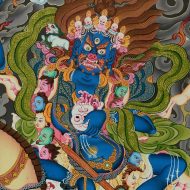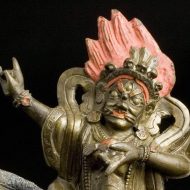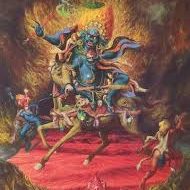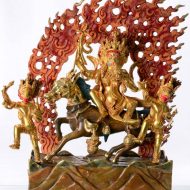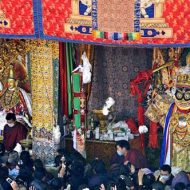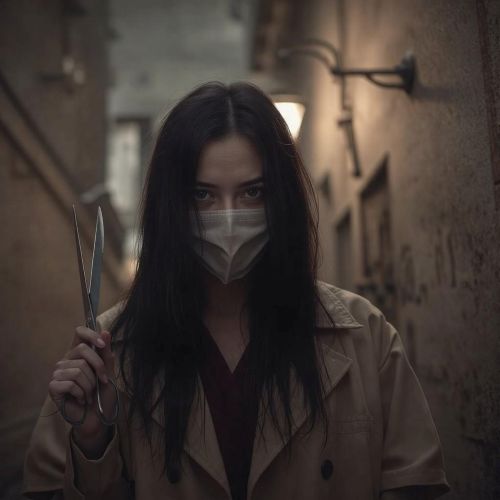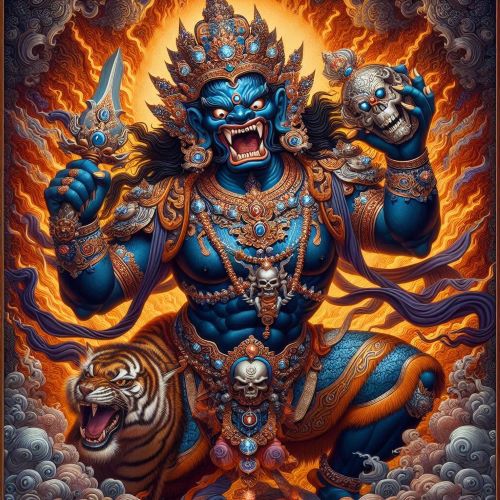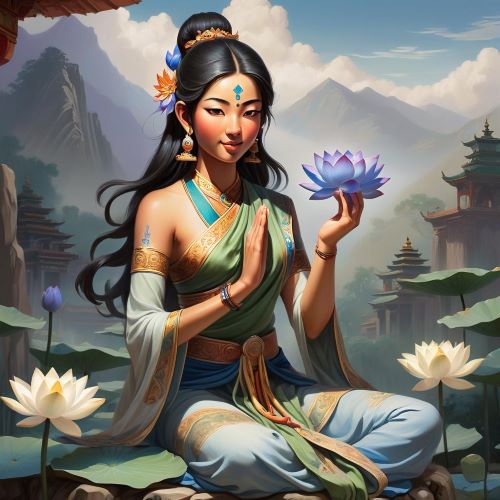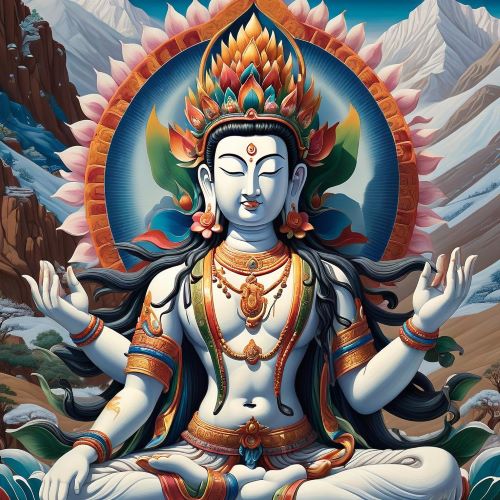Palden Lhamo : The Protector Goddess
Listen
At a glance
| Description | |
|---|---|
| Origin | Tibetan Mythology |
| Classification | Gods |
| Family Members | King of Lanka (Husband) |
| Region | Tibet |
| Associated With | Protection, Violence, Buddhism |
Palden Lhamo
Introduction
One of the most outspoken female Buddhist deities, Penden Lhamo is known for her various roles within the confines of Tibetan Buddhism. She is regarded as the protector of the city of Lhasa, the Dalai Lamas of Tibet and the Gelukpa Order. Legend has it that she was invited to Tibet during the eleventh century from India before which she once reigned as the queen of Sri Lanka’s demons.
She vowed to kill her only son if he did not promise not to lead the people of Lanka to greater violence and cannibalism. The intense figure of Lhamo is meant to represent the will to overcome the obstacles that are in the way of attaining the unity of wisdom and compassion. Her devotee would focus on transforming her energy into creative energy that can transcend the human ego. These images of violence are understood by initiates as sacred symbols of inner transformation in a compassionate religious culture that shuns every form of action, thought or word that might be harmful to other living beings.
Physical Traits
Palden Lhamo only female member of the Eight Guardians of the Law is usually depicted in deep blue and has red hair to amplify her wrathful nature. She’s usually depicted side-saddle on a white mule crossing a sea of blood. The animal has an eye on its left rump, where an arrow was fired by her husband after she killed their son and used his skin as a saddle blanket as he was destined to be the one to end Buddhism. She has three eyes and is often shown drinking blood from a human skull.
Family
According to one account, Palden Lhamo was known as Remati when she was married to the evil king of Lanka. She vowed to end his reign if she did not convert him to Buddhism and prevent him from leading the people of Lanka to greater violence. She tried several times to convince him to renounce his wickedness, but he refused to do so. During this time, while her husband was out hunting, she killed her son as he was being labelled as the one who will bring an end to Buddhism. She ate his flesh, drank his blood and made a saddle out of his skin. She then went on to travel to Tibet, China, Mongolia, and India before eventually settling down on a mountain in eastern Siberia.
After she died, she was reborn in hell and she fought her way out. When she escaped, she stole a sword and a bag of diseases. She then prayed to the Buddha for protection and Buddha Vajradhara (tantric Shakyamuni) appeared before her and asked her to protect the dharma and the Buddhist faith.
Other Names
Palden Lhamo is often referred to as Magzor Gyalmo or Shri Devi. In English descriptions she is known by the monikers Glorious Goddess, the Queen who Repels Armies, or the Queen who has the power to turn back armies. In Sanskrit she is known as Shri Devi and Yakshi Remati while also being known as Ukin Tengri in Mongolia. Some legends also say that the goddess was named Remati when born.
Powers and Abilities
Palden Lhamo has several magical weapons and an extended entourage that she uses to help her in her task of protecting devotees and Buddhism in general. The weapons include a tally-stick scored with curses that is tucked into her serpent waistband; a pair of divination dice; a skin sack full of contagious diseases and a bundle of red curses, which hang upon serpents from the front of her saddle, and a ball of variegated thread that hangs from the rear of her saddle.
Her saddle is made from the skin of a cannibal, and it features a demon’s upper skull and its jawbone at the rear. The reins and bridle of her mule are also made from poisonous serpents. Her mule also gazes over the past, present, and future. The back and front of the mule are the two attendants of Palden Lhamo, namely Makaravakra and Simhavakra. The former is a blue crocodile-headed dakini who leads the mule by its snake reins and latter is a red dakini that guards the rear of the animal.
Modern Day Influence
Palden Lhamo is a central figure in the religious belief system of Tibet, Bhutan and parts of Nepal. Being an iconic figure in Buddhist religious teachings, devotees still worship the goddess for protection even today. She is regarded as a ferocious motherly protectionist who has also been named as the official Dharma Protector of the Ganden monastery and the Dalai Lama.
Every time the Tibetan spiritual leader, the Dalai Lama, goes somewhere, he carries a special thangka, which is a scroll painting of Shridevi. For centuries, no one looked at this thangka, which was kept sealed inside a special tube. In 1940, the current Dalai Lama, who was around seven years old when this painting was made, was met by a large crowd in the city of Lhasa. When the Dalai Lama saw this image near the entrance of his tent, he immediately took it inside and unveiled it. The picture had not been revealed for a long time, and it was replaced in its case.
Related Images
Frequently Asked Questions
What is the Palden Lhamo prayer?
A prayer to Palden Lhamo is a way of invoking her blessings, protection and assistance. There are different prayers to Palden Lhamo, depending on the lineage, tradition and level of practice. Some prayers may require empowerment or initiation from a qualified teacher, while others may be more accessible for general practitioners.
Is Mahakala and Palden Lhamo the same?
Palden Lhamo and Mahakala are not the same, but they are related. Palden Lhamo is a wrathful female protector deity who is an emanation of Tara and Sarasvati. Mahakala is a wrathful male protector deity who is an emanation of Chenrezig or Avalokiteshvara. They are both important dharmapalas or guardians of the Dharma in Tibetan Buddhism.
What is the palden lhamo festival?
The Palden Lhamo festival is a traditional Tibetan festival that honors the wrathful female protector deity Palden Lhamo. It is celebrated on the 15th day of the 10th month of the Tibetan lunar calendar, which usually falls in November or December. The festival is especially popular in Lhasa, where it is also considered as a Women’s Day. On this day, many women and girls dress up in their finest clothes and gather at Barkhor Street to worship Palden Lhamo and her daughter, who is depicted as a frog-like face woman.
What are the benefits of the paldem lhamo mantra?
The Palden Lhamo mantra is:
JO RAMO JO RAMO JO JO RAMO TUNJO KALA RACHENMO RAMO AJIA DAJIA TUNJO RULU RULU HUM JO HUM
The Palden Lhamo mantra is a sacred sound formula that invokes the blessings, protection and assistance of Palden Lhamo, the wrathful female protector deity of Tibetan Buddhism. However, reciting the Palden Lhamo mantra also requires proper initiation, transmission and instruction from a qualified teacher, as it is part of the Vajrayana or tantric Buddhist practice. Without these prerequisites, one may not receive the full benefits or even incur negative consequences from reciting the mantra without authorization.

